PTHrP 1-141 and 1-86 increase in vitro bone formation
- PMID: 20538301
- PMCID: PMC2921615
- DOI: 10.1016/j.jss.2010.02.023
PTHrP 1-141 and 1-86 increase in vitro bone formation
Abstract
Background: Parathyroid hormone-related protein (PTHrP) has anabolic effects in bone, which has led to the clinical use of N-terminal fragments of PTHrP and PTH. Since 10% to 20% of fractures demonstrate healing complications and osteoporosis continues to be a debilitating disease, the development of bone-forming agents is of utmost importance. Due to evidence that regions of PTHrP other than the N-terminus may have bone-forming effects, this study was designed to compare the effects of full-length PTHrP 1-141 to N-terminal PTHrP 1-86 on in vitro bone formation.
Materials and methods: MC3T3-E1 pre-osteoblasts were treated once every 6 d for 36 d with 5, 25, and 50 pM of PTHrP 1-141 or 1-86 for 1 or 24 h. Cells were also treated after blocking the N-terminus, the nuclear localization sequence (NLS), and the C-terminus of PTHrP, individually and in combination. Area of mineralization, alkaline phosphatase (ALP), and osteocalcin (OCN) were measured.
Results: PTHrP 1-141 and 1-86 increased mineralization after 24-h treatments, but not 1-h. PTHrP 1-141 was more potent than 1-86. Treatment with PTHrP 1-141 for 24-h, but not 1-86, resulted in a concentration-dependent increase in ALP, with no effect after 1-h. Exposure to both peptides for 1- or 24-h induced a concentration-dependent increase in OCN, with 24-h exceeding 1-h. Antibody blocking revealed that the NLS and C-terminus are anabolic.
Conclusions: Both PTHrP 1-141 and 1-86 increased in vitro bone formation; however, PTHrP 1-141 was more effective. The NLS and C-terminus have anabolic effects distinct from the N-terminus. This demonstrates the advantage of PTHrP 1-141 as a skeletal anabolic agent.
Copyright 2010 Elsevier Inc. All rights reserved.
Figures

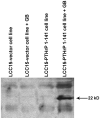
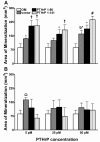
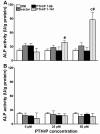
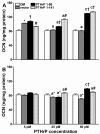
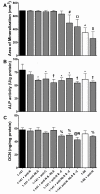
Similar articles
-
Dose-dependence of PTH-related peptide-1 on the osteogenic induction of MC3T3-E1 cells in vitro.Medicine (Baltimore). 2017 Apr;96(17):e6637. doi: 10.1097/MD.0000000000006637. Medicine (Baltimore). 2017. PMID: 28445262 Free PMC article.
-
Effects of differentiation and transforming growth factor beta 1 on PTH/PTHrP receptor mRNA levels in MC3T3-E1 cells.J Bone Miner Res. 1995 Aug;10(8):1243-55. doi: 10.1002/jbmr.5650100815. J Bone Miner Res. 1995. PMID: 8585429
-
Multiple mechanisms are involved in inhibition of osteoblast differentiation by PTHrP and PTH in KS483 Cells.J Bone Miner Res. 2005 Dec;20(12):2233-44. doi: 10.1359/JBMR.050821. Epub 2005 Aug 29. J Bone Miner Res. 2005. PMID: 16294276
-
Studies on the mechanisms of the skeletal anabolic action of endogenous and exogenous parathyroid hormone.Arch Biochem Biophys. 2008 May 15;473(2):218-24. doi: 10.1016/j.abb.2008.03.003. Epub 2008 Mar 10. Arch Biochem Biophys. 2008. PMID: 18358824 Review.
-
Current perspectives on parathyroid hormone (PTH) and PTH-related protein (PTHrP) as bone anabolic therapies.Biochem Pharmacol. 2013 May 15;85(10):1417-23. doi: 10.1016/j.bcp.2013.03.002. Epub 2013 Mar 13. Biochem Pharmacol. 2013. PMID: 23500550 Review.
Cited by
-
Physiological Bone Remodeling: Systemic Regulation and Growth Factor Involvement.Physiology (Bethesda). 2016 May;31(3):233-45. doi: 10.1152/physiol.00061.2014. Physiology (Bethesda). 2016. PMID: 27053737 Free PMC article. Review.
-
Absence of PTHrP nuclear localization and carboxyl terminus sequences leads to abnormal brain development and function.PLoS One. 2012;7(7):e41542. doi: 10.1371/journal.pone.0041542. Epub 2012 Jul 23. PLoS One. 2012. PMID: 22844494 Free PMC article.
-
Exogenous PTHrP Repairs the Damaged Fracture Healing of PTHrP+/- Mice and Accelerates Fracture Healing of Wild Mice.Int J Mol Sci. 2017 Feb 6;18(2):337. doi: 10.3390/ijms18020337. Int J Mol Sci. 2017. PMID: 28178186 Free PMC article.
-
Activation of NF-kappa B signaling promotes growth of prostate cancer cells in bone.PLoS One. 2013;8(4):e60983. doi: 10.1371/journal.pone.0060983. Epub 2013 Apr 5. PLoS One. 2013. PMID: 23577181 Free PMC article.
-
Deletion of the nuclear localization sequence and C-terminus of parathyroid hormone-related protein decreases osteogenesis and chondrogenesis but increases adipogenesis and myogenesis in murine bone marrow stromal cells.J Tissue Eng. 2015 Oct 12;6:2041731415609298. doi: 10.1177/2041731415609298. eCollection 2015 Jan-Dec. J Tissue Eng. 2015. PMID: 35003616 Free PMC article.
References
-
- Burtis WJ, Wu T, Bunch C, et al. Identification of a novel 17,000-dalton parathyroid hormone-like adenylate cyclase-stimulating protein from a tumor associated with humoral hypercalcemia of malignancy. J Biol Chem. 1987;262:7151. - PubMed
-
- Dunbar ME, Wysolmerski JJ. Parathyroid hormone-related protein: a developmental regulatory molecule necessary for mammary gland development. J Mammary Gland Biol Neoplasia. 1999;4:21. - PubMed
-
- Kaiser SM, Sebag M, Rhim JS, et al. Antisense-mediated inhibition of parathyroid hormone-related peptide (PTHrP) production in a keratinocyte cell line impedes differentiation. Mol Endocrinol. 1994;8:139. - PubMed
-
- Civitelli R, Martin TJ, Fausto A, et al. Parathyroid hormone-related peptide transiently increases cytosolic calcium in osteoblast-like cells: comparison with parathyroid hormone. Endocrinology. 1989;125:1204. - PubMed
-
- Wysolmerski JJ, Stewart AF. The physiology of parathyroid hormone-related protein: An emerging role as a developmental factor. Annu Rev Physiol. 1998;60:431. - PubMed
Publication types
MeSH terms
Substances
Grants and funding
LinkOut - more resources
Full Text Sources
Research Materials

